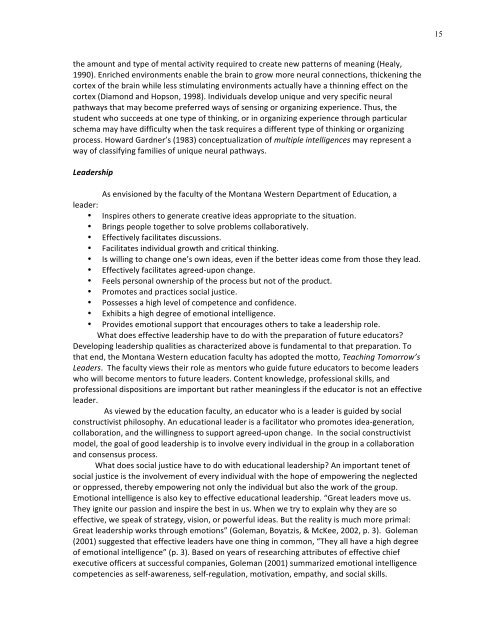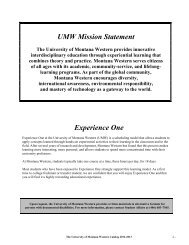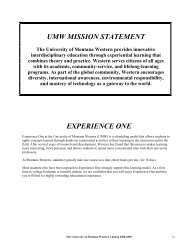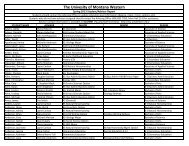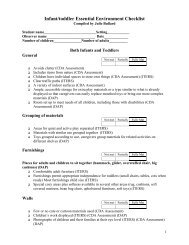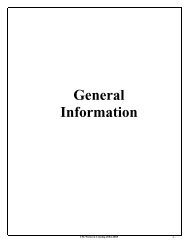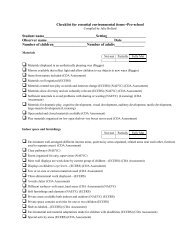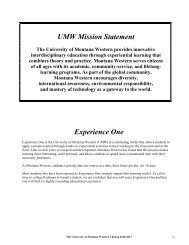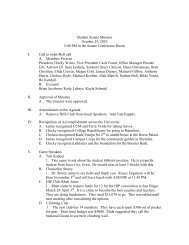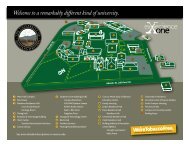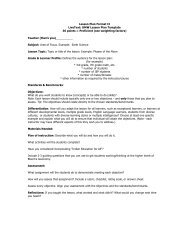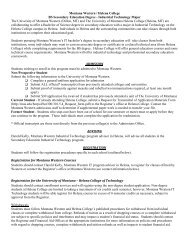TEP Student Handbook - The University of Montana Western
TEP Student Handbook - The University of Montana Western
TEP Student Handbook - The University of Montana Western
You also want an ePaper? Increase the reach of your titles
YUMPU automatically turns print PDFs into web optimized ePapers that Google loves.
the amount and type <strong>of</strong> mental activity required to create new patterns <strong>of</strong> meaning (Healy,<br />
1990). Enriched environments enable the brain to grow more neural connections, thickening the<br />
cortex <strong>of</strong> the brain while less stimulating environments actually have a thinning effect on the<br />
cortex (Diamond and Hopson, 1998). Individuals develop unique and very specific neural<br />
pathways that may become preferred ways <strong>of</strong> sensing or organizing experience. Thus, the<br />
student who succeeds at one type <strong>of</strong> thinking, or in organizing experience through particular<br />
schema may have difficulty when the task requires a different type <strong>of</strong> thinking or organizing<br />
process. Howard Gardner’s (1983) conceptualization <strong>of</strong> multiple intelligences may represent a<br />
way <strong>of</strong> classifying families <strong>of</strong> unique neural pathways.<br />
Leadership<br />
As envisioned by the faculty <strong>of</strong> the <strong>Montana</strong> <strong>Western</strong> Department <strong>of</strong> Education, a<br />
leader:<br />
• Inspires others to generate creative ideas appropriate to the situation.<br />
• Brings people together to solve problems collaboratively.<br />
• Effectively facilitates discussions.<br />
• Facilitates individual growth and critical thinking.<br />
• Is willing to change one’s own ideas, even if the better ideas come from those they lead.<br />
• Effectively facilitates agreed‐upon change.<br />
• Feels personal ownership <strong>of</strong> the process but not <strong>of</strong> the product.<br />
• Promotes and practices social justice.<br />
• Possesses a high level <strong>of</strong> competence and confidence.<br />
• Exhibits a high degree <strong>of</strong> emotional intelligence.<br />
• Provides emotional support that encourages others to take a leadership role.<br />
What does effective leadership have to do with the preparation <strong>of</strong> future educators?<br />
Developing leadership qualities as characterized above is fundamental to that preparation. To<br />
that end, the <strong>Montana</strong> <strong>Western</strong> education faculty has adopted the motto, Teaching Tomorrow’s<br />
Leaders. <strong>The</strong> faculty views their role as mentors who guide future educators to become leaders<br />
who will become mentors to future leaders. Content knowledge, pr<strong>of</strong>essional skills, and<br />
pr<strong>of</strong>essional dispositions are important but rather meaningless if the educator is not an effective<br />
leader.<br />
As viewed by the education faculty, an educator who is a leader is guided by social<br />
constructivist philosophy. An educational leader is a facilitator who promotes idea‐generation,<br />
collaboration, and the willingness to support agreed‐upon change. In the social constructivist<br />
model, the goal <strong>of</strong> good leadership is to involve every individual in the group in a collaboration<br />
and consensus process.<br />
What does social justice have to do with educational leadership? An important tenet <strong>of</strong><br />
social justice is the involvement <strong>of</strong> every individual with the hope <strong>of</strong> empowering the neglected<br />
or oppressed, thereby empowering not only the individual but also the work <strong>of</strong> the group.<br />
Emotional intelligence is also key to effective educational leadership. “Great leaders move us.<br />
<strong>The</strong>y ignite our passion and inspire the best in us. When we try to explain why they are so<br />
effective, we speak <strong>of</strong> strategy, vision, or powerful ideas. But the reality is much more primal:<br />
Great leadership works through emotions” (Goleman, Boyatzis, & McKee, 2002, p. 3). Goleman<br />
(2001) suggested that effective leaders have one thing in common, “<strong>The</strong>y all have a high degree<br />
<strong>of</strong> emotional intelligence” (p. 3). Based on years <strong>of</strong> researching attributes <strong>of</strong> effective chief<br />
executive <strong>of</strong>ficers at successful companies, Goleman (2001) summarized emotional intelligence<br />
competencies as self‐awareness, self‐regulation, motivation, empathy, and social skills.<br />
15


